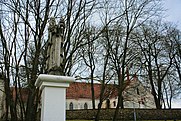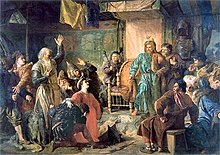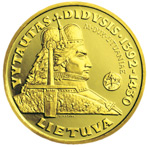This is an old revision of this page, as edited by 211.28.47.151 (talk) at 10:41, 3 May 2009 (Undid revision 286533386 by Iulius (talk)). The present address (URL) is a permanent link to this revision, which may differ significantly from the current revision.
Revision as of 10:41, 3 May 2009 by 211.28.47.151 (talk) (Undid revision 286533386 by Iulius (talk))(diff) ← Previous revision | Latest revision (diff) | Newer revision → (diff) Grand Duke of Lithuania| Vytautas the Great | |
|---|---|
| Grand Duke of Lithuania | |
 17th century painting 17th century painting | |
| Reign | 4 August 1392 – October 27, 1430 |
| Predecessor | Skirgaila |
| Successor | Švitrigaila |
| Burial | Vilnius, Vilnius Cathedral |
| House | House of Kęstutis |
| Dynasty | Gediminids |
| Father | Kęstutis |
| Mother | Birutė |
Vytautas or Vitovt, (Lithuanian: Vytautas Didysis; c. 1350– October 27, 1430), often styled "the Great", was one of the most famous rulers of medieval Lithuania. With the title Didysis Kunigaikštis, the equivalent of king, he was the supreme ruler of his dominions and also a member of the Order of the Dragon.
Vytautas was the ruler (1401–1430) of the Grand Duchy of Lithuania which chiefly encompassed the Lithuanians and Ruthenians. He was also the Prince of Hrodna (1370–1382) and the Prince of Lutsk (1387–1389), postulated king of Hussites. In modern Lithuania, Vytautas is revered as a national hero and was an important figure in the national rebirth in the early 20th century. Vytautas is a popular male given name in Lithuania. Vytautas Magnus University was named after him. Monuments in his honor were built in many towns in the independent Republic of Lithuania during the interwar period, 1918-1939.
Struggle for power
Early life

Born in 1350 in the castle of present-day Senieji Trakai ("Old Trakai"), Vytautas was the son of Kęstutis with his second wife Birutė, cousin of Jogaila, who became King of Poland as Władysław II, and grandfather of Vasili II of Russia.
1377–1384
Main article: Lithuanian Civil War (1381–1384)Vytautas' father, Kęstutis, and his uncle Algirdas, were brothers and did not compete for power. Algirdas was the Grand Duke of Lithuania, and Kęstutis was primarily responsible for defense against the Teutonic Knights. However, after Algirdas' death in 1377, his son Jogaila, became Grand Duke. The harmonious relationship of his father and uncle ended, and a struggle for power between them ensued. In 1380, Jogaila signed the secret Treaty of Dovydiškės with the Teutonic Knights against Kęstutis. When Kęstutis discovered this in the following year, he seized Vilnius, imprisoned Jogaila, and made himself Grand Duke. However, Jogaila managed to escape and raised an army against Kęstutis, and his son Vytautas. The two opposing sides confronted each other but never engaged in battle. Kęstutis was ready to negotiate, but he and Vytautas were arrested and transported to Kreva Castle. One week later, Kęstutis was found dead. Whether he died of natural causes or was murdered is still a matter of debate amongst historians.

In 1382, Vytautas was able to escape from Kreva. After the escape, he sought help from the Teutonic Knights. At the time Jogaila was negotiating with the Teutonic Order. They formulated the Treaty of Dubysa, by which Jogaila promised to accept Christianity, become an ally of the Order, and give the Order some territory of Samogitia up to the Dubysa River. However, the treaty was never ratified. In summer 1383, the war between Jogaila and the Order started up again. Vytautas was baptized in the Catholic rite, receiving the name of Wigand (Lithuanian: Vygandas). Later, however, he drifted away from Christianity and back towards paganism. Vytautas participated in several raids against Jogaila. In January 1384, Vytautas again promised to cede part of Samogitia, to the Teutonic Order, up to the Nevėžis River in return for the title of Grand Duke of Lithuania. However, in July of the same year, Vytautas decided to abandon the Teutonic Knights and reconciled with Jogaila. He then proceeded to burn three important Teutonic castles, and he redeemed all Kęstutis' lands, except for Trakai.
1389–1392
Vytautas participated in the signing of Union of Kreva with Poland in 1385 and he was re-baptized in 1386 in the Catholic rite, receiving the name Alexander. This treaty provided for the marriage of Jogaila to Jadwiga of Poland, and for him to become the King of Poland. He left his brother Skirgaila as a regent of Grand Duchy of Lithuania. However, he was unpopular with the people and Vytautas saw an opportunity to become the Grand Duke again. In 1389 he started a war and attacked Vilnius but failed. Vytautas was forced to ask the Teutonic Knights for help for the second time in the beginning of 1390. Vytautas had to promise to keep the original agreement of 1384, and turn over Samogitia to the Order. His army now attacked Lithuanian lands.
To further advance his influence, Vytautas married his only daughter Sophia to Vasili I of Russia in 1391. The Polish nobility was unhappy that Jogaila, their new king, now Władysław II Jagiełło, spent too much time on the affairs of the Grand Duchy of Lithuania. It was clear that the war could continue for years and would not bring any benefit to the country. In 1392, Wladyslaw II Jagiełło's envoy, Henry of Masovia, offered Vytautas to become his regent instead of Skirgaila. Vytautas accepted and once again burned three Teutonic castles and returned to Vilnius. Jagiełło and Vytautas signed the Astrava Treaty in which Vytautas redeemed all Kęstutis' lands, including Trakai, and was given more. He could rule Grand Duchy of Lithuania in the name of Wladyslaw II Jagiełło. After Vytautas death all lands and powers were to be returned to the King of Poland.
Grand Duke of Lithuania

Policy towards the East
Vytautas continued Algirdas' vision to control as many Muscovy lands as possible. Many lands were already under the Grand Duke's rule, but the rest were controlled by the Mongols. Tokhtamysh, Khan of the Golden Horde, sought Vytautas' help when he was removed from the throne in 1395 after his defeat by Timur. An agreement was reached that Vytautas would help Tokhtamysh to regain power, and the Horde would cede more lands to the Grand Duchy of Lithuania in return. In 1398, Vytautas' army attacked a part of the Crimea and built a castle there. Now Lithuania spanned from the Baltic Sea to the Black Sea. A number of Tatar captives were brought to the ethnic Lithuania.

Inspired by this successful campaign, Vytautas and Wladyslaw II Jagiełło won support from Pope Boniface IX for organizing a crusade against the Mongols. This political move also demonstrated that Grand Duchy of Lithuania had fully accepted Christianity and was defending the faith on its own, and that the Teutonic Knights had no further basis for attacks against Lithuania. The campaign resulted in total defeat at the Battle of the Vorskla River in 1399. Over twenty princes, including two brothers of Wladyslaw II Jagiełło, were killed, and Vytautas himself barely escaped alive. This came as a shock to the Grand Duchy of Lithuania and Poland. A number of territories revolted against Vytautas, and Smolensk was retaken by its hereditary ruler, George of Smolensk and not re-conquered by Lithuanians until 1404. Vytautas waged a war in 1406-1408 against his son-in-law Vasili I of Moscow and Švitrigaila, a brother of Jogaila who with the support of the Teutonic Order had declared himself grand prince. A major stand-off between the two armies ended without a battle in the Treaty of Ugra, by which Velikiy Novgorod was granted to Jogaila's brother Simeon Lingwen, and the important city of Pskov to Jogaila's envoy Jerzy Nos, the latter settlement a clear violation of the treaty of Raciąż.The war with Muscovy ended in December 1408, on terms which made further conflict with the Teutonic Order inevitable, despite Hermann II of Celje's attempt to negotiate a solution.
Wars against the Teutonic Order
Main article: Polish-Lithuanian-Teutonic War
In 1398 in preparation for the crusade against the Golden Horde, Vytautas had signed the Treaty of Salynas with the Teutonic Knights and transferred Samogitia to them. Samogitia was especially important for the order because it separated Teutonic Knights, based in Prussia, from the Livonian Order, based in Latvia. The two orders desired to unite and form a mighty force. However, the knights ruled Samogitia only for three years, because in 1401 the Samogitians, supported by Vytautas, rebelled and burned two castles. The knights received support from Švitrigaila, brother of Jagiełło, who desired to take Vytautas' title. In 1404 Peace of Raciąż was signed which, in essence, repeated the Treaty of Salynas: Samogitia was transferred to the Teutonic Knights. Poland promised not to support Lithuania in case of another war. The knights promised to support Vytautas in the east and not to support any Gediminid who could have claims to the Grand Duke of Lithuania title. However, the treaty did not solve the problems, and all the parties prepared for a war.
In 1408 Vytautas reached peace in the east and returned to Samogitia matters. In 1409 the second Samogitian uprising, backed by Vytautas, against the Teutonic Knights started. The rebels burned Skirsnemunė castle. Since both Poland and Lithuania supported the rebels, the war started. Vytautas gathered a large army from 18 lands under his control. The army joined Polish forces and advanced towards the Teutonic headquarters at the castle of Marienburg (present-day Malbork). In 1410 Vytautas himself commanded the forces of the Grand Duchy in the Battle of Grunwald (also called the Battle of Tannenberg). The battle ended in a decisive Polish-Lithuanian victory. Even though the siege of Marienburg was unsuccessful, the Teutonic Knights never regained their strength and from then on posed a reduced threat to Poland-Lithuania.
As a result of the Peace of Thorn of 1411, Vytautas received Samogitia for his lifetime. However, the parties could not agree on the border. Sigismund, Holy Roman Emperor, agreed to mediate the dispute. In 1413, it was declared that the whole right bank of the Neman River was Samogitia and therefore belonged to Lithuania. The Teutonic Knights disagreed and a new war started in 1414. The war lasted for just a couple of months and the dispute was brought to the Council of Constance. Even though the dispute was not resolved, the Samogitians had a chance to present their case to the leaders of Europe. It is seen as an important event in the diplomatic history of Lithuania. Several other mediation attempts failed and yet another war with the Teutonic Order started in 1422. After a couple of months of fighting, the Treaty of Lake Melno was signed. Samogitia was returned to Lithuania in perpetuity, while the city of Memel (present-day Klaipėda) and surrounding territories stayed with the Order. This border, as established by the treaty, remained stable for some 500 years until the Memel Territory dispute of 1923. With peace established, Vytautas could now concentrate on reforms and the relationship with Poland.
Relationship with Poland
In 1399 Jadwiga of Poland and her newborn died in childbirth. Jogaila's power in Poland was jeopardized as he was a foreigner king with no other ties to the throne but his wife. Also, the defeat at Vorskla forced a re-evaluation of the relationship between Poland and Lithuania. The result was the Union of Vilnius and Radom in 1401. Vytautas was granted wide autonomy, but after his death the title and powers of Grand Duke of Lithuania were to be transferred to the king of Poland. In case Jagiełło died first without an heir, the Polish nobility agreed not to elect a new king without consulting Vytautas. The unique feature of this union was that the Lithuanian nobility presented their own document: for the first time somebody other than dukes played a role in the state matters.

Vytautas was one of the creators of the Union of Horodło with Poland in 1413. According to the act of the union, the Grand Duchy of Lithuania was to retain a separate Grand Duke and its own parliament. At the same time both the Polish and Lithuanian Sejms were to discuss all the important matters jointly. This union was important culturally as well as politically because it granted Lithuanian Christian nobles the same rights as the Polish szlachta. This act did not include Orthodox nobles. This paved the way for more contacts and cooperation between the nobles and for the Polish-Lithuanian Commonwealth.
In January of 1429 Vytautas already had received the title of King of Lithuania with the backing of Sigismund, Holy Roman Emperor, but the envoys who were transporting the crown were stopped by Polish magnates in autumn of 1430. Another crown was sent, but Vytautas died in the Trakai Island Castle several days before it reached Lithuania. He was buried in the Cathedral of Vilnius. The knowledge about his remains has been lost.
According to 1911 Encyclopaedia Britannica, Vytautas "was certainly the most imposing personality of his day in Eastern Europe, and his martial valour was combined with statesmanlike foresight."

Reforms
Vytautas backed the economic development of his state and introduced many reforms. Under his rule the Grand Duchy of Lithuania gradually became more centralized, as local princes with dynastic ties to the throne were replaced by the governors loyal to Vytautas. The governors were rich landowners who formed the basis for the Lithuanian nobility. During Vytautas' rule, the influential Radziwiłł and Goštautai families began their rise.
Title
- Latin: magnus dux Lithuanie terrarumque Russie etc
- English translation: Grand duke of Lithuania, Ruthenia etc
(Breviary excerpt from a document in 1422: Nos Alexander alias Witoldus eadem < Dei > gracia, magnus dux Lithwanie terrarumque Russie etc.)
Observe: Technically, Vytautas was most of his reign a nominal vassal of his cousin Jogaila, then king of Poland, who used an additional title Supreme Prince of Lithuania.
See also
- Gediminids
- House of Kęstutis – family tree of Vytautas
- Order of Vytautas the Great
| Monarchs of Lithuania | |||||||||||
|---|---|---|---|---|---|---|---|---|---|---|---|
| Kingdom of Lithuania |
| ||||||||||
| Grand Duchy of Lithuania |
| ||||||||||
| Polish–Lithuanian Commonwealth |
| ||||||||||
| Kingdom of Lithuania |
| ||||||||||
| Titular rulers are in italics. | |||||||||||
Notes
- Alternate names in modern and medieval languages include Template:Lang-la; Rus'ian: Vitovt; Template:Lang-be; German: Witold and Vitort; Template:Lang-pl
- Turnbull, Stephen (2004). The Hussite Wars 1419-36. Ospreypublishing. p. 11. ISBN 1841766658.
{{cite book}}: Cite has empty unknown parameter:|coauthors=(help) - Template:Pl icon Paweł Jasienica (1988). "Władysław Jagiełło". Polska Jagiellonów. Warsaw: Państwowy Instytut Wydawniczy. ISBN 83-06-01796-X.
- Template:Pl icon Tekla Wołowska (1860). Historya Polska (Polish History). Paris: L. Martinet. p. 433.
- Template:Pl icon Antoni Prochaska (1908). Król Władysław Jagiełło. Kraków: Akademia Umiejętności. p. 240.
{{cite book}}: Cite has empty unknown parameter:|coauthors=(help)
References
- Template:Lt icon Inga Deidulė, Vytauto Didžiojo įvaizdžio genezės mįslė, - "ieškokite moterų", Vartiklis. Accessed May 20, 2006.
- Template:Lt icon Andrius Mingėla, Vytautas Lietuvos didysis kunigaikštis, Juventa high school. Accessed May 20, 2006.
- Oscar Halecki, Borderlands of Western Civilization: A History of East Central Europe, 2nd edition, Chapter 8, Simon Publications, July 2001, ISBN 0-9665734-8-X
- Vytautas and Karaims, Lithuanian Karaims Culture Community. Accessed May 20, 2006.
| Preceded bySkirgaila | Grand Duke of Lithuania 1392-1430 |
Succeeded byŠvitrigaila |